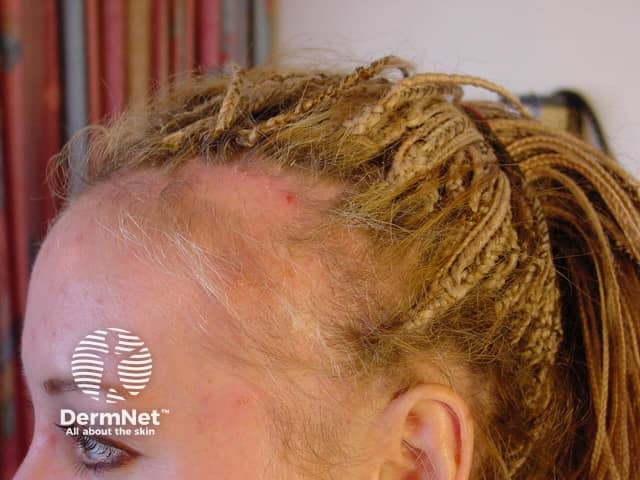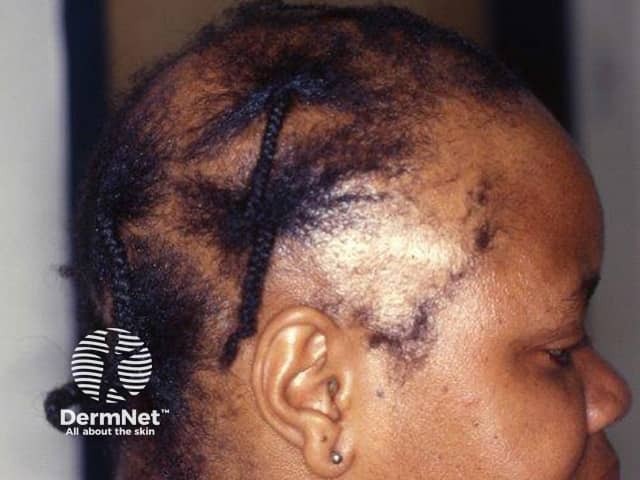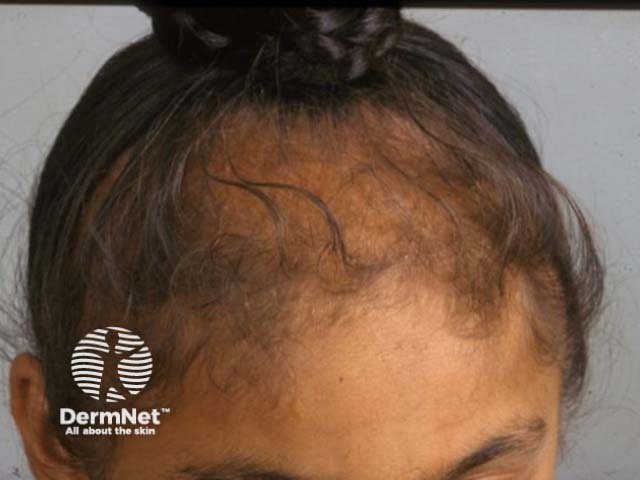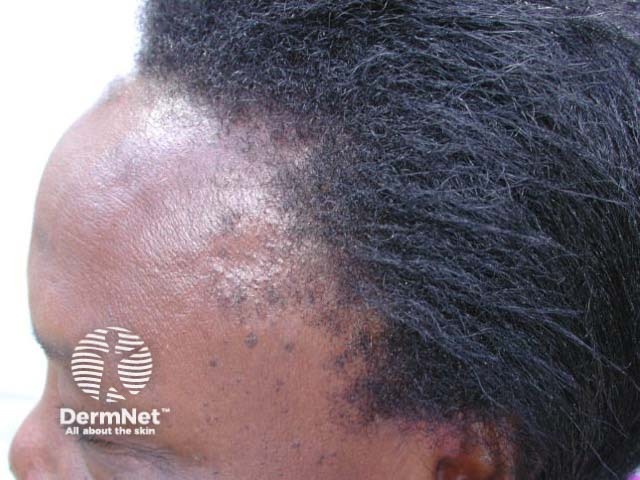Main menu
Common skin conditions

NEWS
Join DermNet PRO
Read more
Quick links
Traction alopecia — extra information
Traction alopecia
Author: Anila Kapadia, Dermatology Registrar, York Teaching Hospital NHS Foundation Trust, United Kingdom. Advisor to the content: Dr. Calum Lyon, Consultant Dermatologist, York Teaching Hospital NHS Foundation Trust, United Kingdom. Copy Editor: Clare Morrison. 2014
Introduction
Causes
Clinical features
Histological findings
Treatment
What is traction alopecia?
Traction alopecia is a form of acquired hair loss that results from prolonged or repetitive tension on the scalp hair. It was first described in 1907 in subjects from Greenland who had developed hair loss along the hairline due to prolonged wearing of tight ponytails.
What causes traction alopecia?
Alopecia due to traction can be caused by:
- Regularly wearing tight chignon, cornrows, dreadlocks, weaves and braids
- Using hair extensions
- Using chemical relaxers and rollers.
It can also be due to the weight of excessively long hair. It is commonly associated with African American females who wear tight braids resulting in hair loss on sides of the head (temporal scalp). Traction alopecia has also been described in Sikh males who twist their uncut scalp hair tightly on the scalp (resulting in scalp alopecia) or their uncut beard below the chin (causing submandibular traction alopecia).
Traction alopecia affects people of any ethnic background or age. The likelihood of developing traction alopecia increases with age, likely due to a prolonged history of these hair practices.
What are the clinical features of traction alopecia?
There is a large variation in the pattern of clinical presentation of traction alopecia. It there is no suspicion of traction, it can be difficult to diagnose. Patients may present with:
- Itching
- Redness
- Scaling
- Folliculitis or pustules
- Multiple short broken hairs
- Thinning and hair loss
Traction alopecia mostly affects the front (frontal) and sides of the scalp but the location of traction alopecia wholly depends on an individual's hair care practice, which may or may not is related to their ethnic background. "Fringe sign" is commonly found in patients with traction alopecia of the marginal hairline – this means that some hair is retained along the frontal and/or temporal rim of the hairline. Initially, traction alopecia is noncicatricial (without scarring), but prolonged and excessive tension leads to destruction of the hair follicles and permanent alopecia.

Traction alopecia

Traction alopecia

Traction alopecia

Traction alopecia

Traction alopecia

Traction alopecia
What are the histological findings in traction alopecia?
The histological findings of a skin biopsy taken from an area of traction alopecia differ depending on its stage of progression.
Early stages present with:
- Trichomalacia (thinned out hair)
- An increased number of catagen (intermediate stage of hair cycle) and telogen hairs (bulb hair)
- The normal number of telogen follicle
- Preserved sebaceous (oil) glands.
At a later stage:
- Vellus hairs (fine short hairs) develop
- Sebaceous glands and terminal hair follicles reduce and are replaced by fibrotic fibrous tracts (scars).
- Inflammation is mild to absent.
What is the treatment of traction alopecia?
People with traction alopecia should consider changing hair care and styling practice to prevent further deterioration.
- Loosen the hairstyle.
- Cut long hair.
- Avoid exposing affected hair and scalp to chemicals and heat.
Medical treatment options reported to have been used in traction alopecia include:
- Antibiotics to prevent infection
- Topical or intralesional steroids
- Topical antifungal shampoos
- Biotin supplements
- Minoxidil
- Hair replacement surgery
References
- Eds. Burns T, Breathnach S, Cox N, Griffiths C. Rook's Textbook of Dermatology. 8th edition. Wiley-Blackwell Publications.
- Samrao A, Zedek D, Price VH et al. The ‘Fringe sign’ a useful clinical finding in traction alopecia of the marginal hair line. J Clin Exp Dermatol Res 2011; 2: 117. Doi.10.4172/2155-9554.1000117. PubMed
- James J, Saladi RN and Fox JL. Traction alopecia in Sikh male patients. Am Board Fam Med. 2007; 20(5): 497–8. PubMed
- Deepika P, Sushama M, Chidrawar VR, et al. Traction Alopecia: Review. J Global Trends in Pharmaceuticals Sciences. January–March 2014; 5(1): 1431–42.
On DermNet
- Hair care practices in women of African descent
- Hair loss
- Melanoma in skin of colour
- Psychological effects of hair loss
- Trichoscopy of generalised noncicatricial hair loss
- Trichoscopy of localised noncicatricial hair loss
